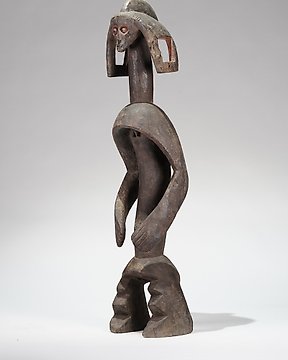
Mumuye - Nigéria (Nincs minimálár)
Nr. 85192587

Nr. 85192587

An Ibo mask from the South-West of Nigeria, composed in two parts, firstly a main face with expressive facial features of an opened mouth showing teeth, arched nose, hollowed out eyes, which are outlined in black, the eyebrows run in arches with a black dotted line and stand out against the surface covered with white pigments, as do decorative scars on the temples, next to the mouth and on the cheeks, which are also accentuated in black, there are stray ropes around the rims of this mask. The top of the head is ornamented carrying another full figure who is also wearing a mask, similar to the one it is standing on. This figure is dressed in ceremonial attire, standing straight, carrying a bottle in its left hand, and a cane in the rights one, the figure is wearing a large headdress, inlayed with mirrors; traces of ritual use, signs of use, some cracks.
"Every Igbo town differs in terms of its range of festivals and types of masks, and oftentimes the spiritual and stylistic forms intermingle between regions. However, masking traditions throughout the various Igbo regions share underlying themes and similar spirits. Of the two most important mask types among the Igbo-- those idealizing the qualities of young women, and those representing the powers of men, the maiden mask embodies the former. When the mask is worn, always by a man, the maiden spirit a dancer personifies represents the ideals of youthful feminine grace and beauty, albeit exaggerated both in the masks and the performance of them.
Igbo models of beauty are based on both physical and moral dimensions. Physically a girl should be tall and slender, with a long neck, full and pointed breasts, light complexion and small features, her hair elaborately dressed (preferably in the crested style) and her features brought out by facial tattoos. These observable qualities mirror the spiritual traits desired by Igbo males - purity, as defined by the paleness of her complexion, grace in the form of
her facial features and the manner in which the spirit is danced, obedience, good character, and generosity. In addition, the crested hairstyle, which is often considered a sign of wealth or royalty, is a symbol of the young Igbo maiden as the source of bride-wealth for her family upon her marriage. Such physical and moral ideals are often not matched in reality, and are not necessarily meant to the maiden spirits are transcendent, a connection between Igbo desires of beauty and the spiritual awesomeness of the incarnate dead.
Maiden mask artists favored red, orange, yellow, and black pigments to highlight their carvings, along with other colors. As in a number of the more elaborate masks, which can have anywhere from one to three hair crests, this maiden has three crests dramatically pairing positive and negative space.
Maiden masks are used mostly during agricultural festivals (usually the dry season) and the second funerals of prominent society members. On latter occasions maiden spirits are invoked alongside other spirits as appropriate escorts of the highly respected dead into the spirit world. During agricultural or other ceremonies, however, maiden spirits appear to aid in watching over the living and to promote abundant harvests, fertility, and general prosperity. Maiden spirits are light-hearted in contrast to more menacing spirits of the Igbo world, which often generate a more serious atmosphere. Maiden maskers perform almost theatrically, as if in a play, their purpose to entertain both human and spirit audiences."
SOURCE:
Aniakor, Chike C. and Herbert M. Cole. Igbo Arts: Community and Cosmos. Museum of Cultural History, University of California: Los Angeles, 1984.
Hogyan vásárolhatok a Catawiki-n?
1. Fedezzen fel valami különlegeset
2. Tegye meg a legmagasabb licitet
3. Fizessen a biztonságos és védett rendszert használva